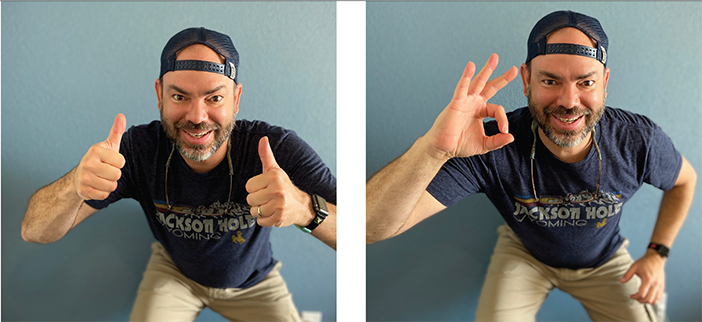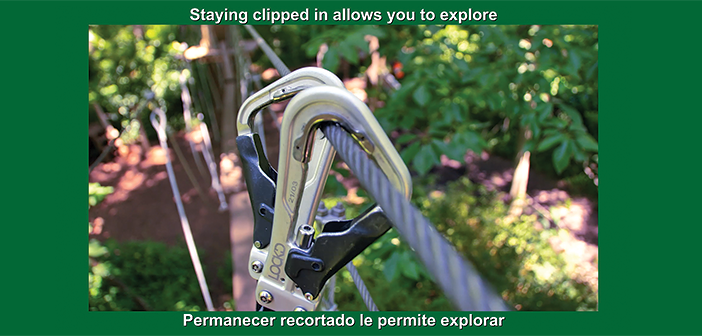Did you take a class in a different language in high school or college? Did you feel uncomfortable? Now, imagine that your high school Spanish is all you had to take you through a (perceived) high-risk aerial adventure experience with Spanish-speaking guides. How would you all communicate?
Communication, according to the Merriam-Webster definition, is a process by which information is exchanged between individuals through a common system of symbols, signs, or behavior. There are different types of communication; here we’ll focus on verbal and non-verbal. Verbal communication is through spoken and written word. Nonverbal communication is through sign languages, charts, photos, pictures, symbols, body language, facial expression, eye contact, and head and hand movements.
Language barriers are problems or issues that interfere with a person’s ability to send, receive, and understand a message, i.e., communicate. According to the University of Science and Technology in the United Arab Emirates, language barriers generally arise in several areas:
1. The way a message is originated and sent by a sender.
2. The context of a message.
3. The way a message is received and understood by the receiver.
These language barriers can have significant negative impacts on a user experience. Consider the health care industry: Increased communication errors in outpatient and hospital-based settings have been widely documented as a negative impact of language barriers on medical care.
But there are solutions. For example, to reduce the margin for error in pre-hospital care, emergency medical services providers have implemented the use of symbol cards to communicate with patients who do not speak English. These cards use images of common injuries and illnesses as well as a pain scale to support nonverbal communication.
Similar tools could have applications at aerial adventure operations. To understand what those might be, let’s first examine several consequences language barriers can have in an aerial adventure context.
Impacts on Aerial Adventures
In the United States, adventure operators in various parts of the country grapple with language barriers due to tourism, their proximity to other countries, and resident demographics.
For example, Hawaii-based operations receive visitors from China, Japan, and other nearby countries. In Puerto Rico, Spanish is the main language spoken, with 50 percent of Puerto Ricans speaking English fluently daily and only 5 percent speaking English at home, according to 2017 census data. Given that 3.7 million tourists visit the island of Puerto Rico annually (many from the mainland U.S., where English is the primary language), the ability to communicate bilingually is very important to aerial parks operating there. Why?
Anxiety. The risk of not being understood or not being able to understand a guide’s instruction, combined with concern about the inherent risk of the adventure experience, can lead to anxiety for participants. Additionally, language barriers can make it difficult for a guide to recognize or manage that guest’s anxiety.
Cross-cultural miscommunication. When addressing a customer from a different cultural background whose first language is not English, an instructor or guide may assume similarities instead of differences. Body behaviors have different meanings in different cultures, though. For example, a thumbs-up is a rude gesture in Iran, Iraq, and Afghanistan, whereas it means “good job” or approval in the United States. Another example: The common sign for “OK” in the U.S., means “zero” in some cultures and is considered highly vulgar in others.
An assumption that nonverbal signs and symbols are universal can easily lead to confusing and even offensive cross-cultural (mis)communication between a guest and a guide.

Nonverbal signs and symbols aren’t always universal. The thumbs-up and “OK” signs (demonstrated here by author José González) are positive signs of approval in the United States, but are considered rude and vulgar in other cultures.
Safety. A language barrier may limit a participant’s ability to follow directions while at height, transferring between elements, for example, or communicating with a rescue team during an emergency. An inability to relay or process safety information presents significant risk management concerns for both guests and staff.
Liability. Language barriers can also open an operation up to liability concerns. “The greatest issue here is operators not having waivers in alternative languages,” says Granite Insurance CEO Cameron Annas. “That very much leads to issues during a lawsuit where [participants]can claim they didn’t understand the waiver and the operator did not provide alternative options to view the waiver.”
So, what solutions exist to help operators bridge communication gaps and break down language barriers?
Breaking Down Barriers
Jenni Clock, a K-12 specialist for Project Adventure, which offers adventure-based programming for English language learners in Massachusetts, has some advice for aerial operators working across language barriers:
1. Less is more when creating written materials for participants. Consider how many words are on one page or one sign—keep it simple.
2. Use visuals. And be sure the image used supports the text/speech rather than distracts the reader from it.
3. Be welcoming. When English is not someone’s first language, it is important to start relationship building right off the bat. Make people feel connected and welcome.
4. Translate. There are many ways to translate information (which we’ll explore later), and one that Clock embraces is peer translation—when a friend or acquaintance interprets for someone who doesn’t speak the language well. She has seen this to be particularly effective in learning environments with high-school age kids. In an adventure park setting, staff who speak other languages could serve as peer translators/interpreters if needed.
Nonverbal communication plays an important role in our daily life and in the aerial adventure industry. Employees communicate with patrons constantly on any given day of operation through every step of the experience, from orientation to wrap up. Tools that improve our nonverbal communication across language barriers can be a tremendous asset to aerial operations.
Consider the paramedic symbol cards: Could cards with an anxiety scale (instead of a pain scale) be useful at briefings to help guides check in with guests about nerves? How might that anxiety scale improve our ability to facilitate a positive experience for an anxious guest who is a non-English speaker?
Better visual communication is one reason Outdoor Venture Group implemented video briefings at its six The Adventure Park operations. The videos are also subtitled in both English and Spanish, says Candie Fisher, president of Outdoor Venture Group. The parks serve tourists from all over the world, but the Spanish subtitles, in particular, says Fisher, were implemented because, anecdotally, the operations were seeing an increasing number of Spanish-speaking guests.
In addition to efficiently providing information in multiple languages simultaneously, briefing videos with closed captioning also help to better serve guests who are hearing impaired.
Real-time translation is also valuable. To support that, The Adventure Park parks have an internal communication platform, Beekeeper, with a built-in translator function.
As mentioned earlier, bilingual or multilingual staff members can also be excellent interpreters. Puerto Rico-based operator Ecoquest Adventure and Tours employs bilingual professionals. A scan through online job postings for positions in the aerial adventure industry also showed several operators, primarily those in southern states but also some in Oregon, are actively looking for staff who both speak English fluently and are bilingual.
Bilingual signage. At Toro Verde Aerial Adventure Park in Puerto Rico, bilingual (English and Spanish) signs can be found throughout the property. Wayfinding signs help guests to navigate around the property independently and can lower some of the anxiety that is created when experiencing a language barrier. “Selfie” signs—places where guests are encouraged to take photographs—that read “Yo conquisté el monstruo / I conquered the monster” are an example of how bilingual signage can be used to create an environment that is more engaging and inviting to guests across language barriers.
Waivers are a barrier that it seems most operators have yet to address. There is scant evidence that U.S. aerial adventure operations are offering waivers in any language other than English. While some operators do offer a release in Spanish, this is not an industry-wide norm. That is concerning given that, according to the U.S. Census Bureau, 40 million people speak Spanish in the U.S. and 26 million people in the U.S. report that they speak English less than “very well.”
Why Now?
We put a high value on efficiency over empathy in many businesses, but the ability to connect across language barriers is something worth investing resources in. As our world opens back up and we receive visitors again, the opportunity to address this issue is right in front of us.
Some simple solutions and tips to consider for breaking down language barriers at your operations:
Be patient with non-English speakers from other cultures.
Use pictures, visual aids, and diagrams in your briefings.
Demonstrate, don’t just tell.
Repeat messages in multiple ways: verbal, visual, written (e.g., a video with closed captioning).
Translate documents into other languages and have copies available.
Post multilingual signage throughout the property to remind visitors about the rules, identify meeting locations, and highlight fun activities like “selfie” spots.
Have laminated cards with pictures and essential words in different languages that guides can carry on course.
Identify team members that can serve as interpreters.
Set employees up with free tools like smartphone apps or Google Translate to facilitate real-time communication.
Offer employees a subscription to Duolingo or another language learning course to build multilingual skills among staff.
Offer training to all staff members on essential words and phrases in a second language.
Offer training to all staff members on gestures that are inappropriate in other cultures.






